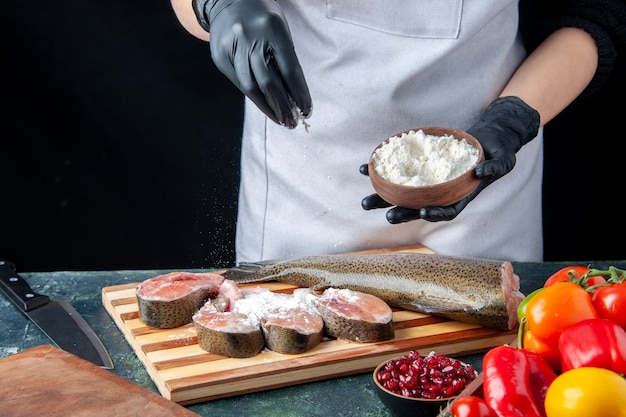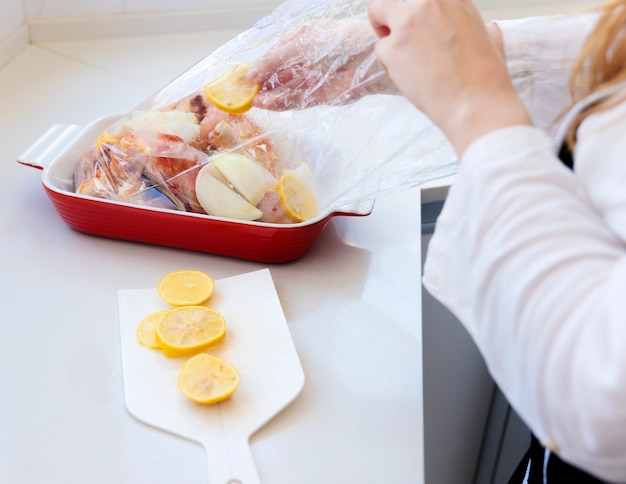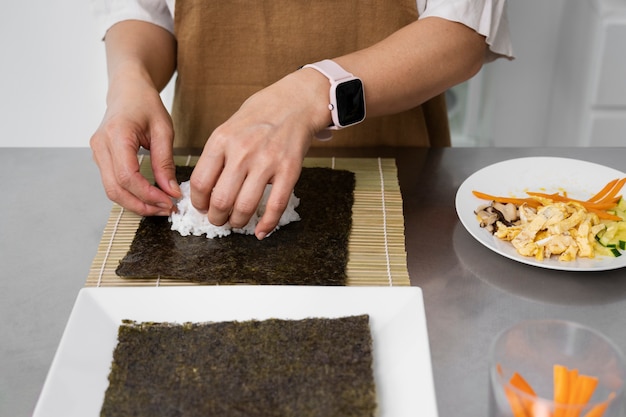Let's talk about flounder. It's a fish that's been a mainstay in my kitchen for years. It's light, delicate, and oh-so-delicious, especially when baked in the oven. But getting it just right? Well, that's where a bit of kitchen know-how comes in handy. I'm going to share all I've learned about baking perfect flounder, from choosing the right fish to nailing that ideal cooking time and temperature. Get ready, this is going to be good!
(Part 1) Choosing the Right Flounder

First things first, you need to choose the right flounder. Think of it like picking the perfect ingredient for a culinary masterpiece – it's the foundation of your dish. Now, I'm not talking about floundering around in the supermarket like a lost fish (though that can happen, trust me!), I'm talking about selecting the best flounder for your oven-baked delight.
Fresh vs Frozen: The Great Debate
Ah, the age-old question: fresh or frozen? Well, I've been on both sides of the fence, and let me tell you, both can be absolutely wonderful. fresh flounder, if you're lucky enough to find it at a reputable fishmonger, has a vibrant, delicate flavour that's simply unmatched. It's like a taste of the sea, straight from the ocean. But if, like me, fresh flounder isn't always readily available, frozen flounder can be just as delicious. The trick is to find flash-frozen flounder that's been properly handled. You'll want to make sure there are no ice crystals on the fish; those are a sign that it's been frozen for a while, and the quality might have suffered.
Freshness – How to Tell If Your Fish is Good
If you're opting for fresh flounder, there are a few things to look for:
- Bright, Clear Eyes: This is a telltale sign of fresh fish. They should be clear and not cloudy or sunken.
- Firm Flesh: The flesh of the flounder should be firm to the touch, not mushy or flabby.
- Slight Ocean Fresh Smell: Fresh flounder should have a clean, slightly briny aroma. Don't be afraid to give it a gentle sniff, it's part of the process!
- Avoid Fishy or Ammonia Smells: If the flounder smells fishy or has an ammonia-like odour, that's a clear indication that it's not fresh and you should avoid it.
The Right Size Matters
When it comes to size, you want to aim for flounder that's about 1-1.5 inches thick. This will ensure the fish cooks evenly and doesn't dry out. If you happen to find thicker pieces, no worries, you can make shallow cuts into the fish to help it cook through more evenly. It's a little trick I've learned that makes a big difference!
(Part 2) Prepping Your Flounder for the Oven

Okay, so you've got your chosen flounder. Now it's time for a little preparation. This is the stage where you get to set the scene for your perfect baked flounder.
Cleaning and Scaling: The Basics
If you're working with a whole flounder, you'll need to clean and scale it. Don't let the words "clean" and "scale" intimidate you; it's actually pretty straightforward. You can ask your fishmonger to do it for you, or if you're feeling adventurous, you can try it yourself. There are plenty of excellent tutorials online that will walk you through the process step by step. The main goal here is to remove the guts and scales, leaving you with a nice, clean fillet.
To Skin or Not to Skin: A Matter of Preference
Now, you have the option to skin the flounder or leave the skin on. I've tried both, and personally, I prefer to skin it. Flounder skin can sometimes be a bit tough and chewy, and I find the fillets taste better without it. However, some people love the flavour and texture of the skin, so it's really a matter of personal preference.
Seasoning: Where the Flavour Comes Alive
This is the fun part – seasoning! This is where you can unleash your creativity and really personalize your flounder. A simple sprinkle of salt and pepper is always a winner, but you can also experiment with other herbs and spices. I've been known to add a pinch of paprika for a hint of smokiness, a dash of garlic powder for a touch of warmth, or even a sprinkle of dried herbs like oregano or thyme for a Mediterranean vibe. The possibilities are endless, so feel free to play around and find the perfect flavour combination for you!
(Part 3) The Oven Baking Technique

Now you've got your perfectly prepped flounder, it's time to head to the oven. I've experimented with different methods and temperatures over the years, and I've learned a few golden rules that make all the difference.
Parchment Paper: The Key to a Non-Stick Experience
One of the best things I've discovered is the magic of parchment paper. It's a true game-changer. Parchment paper prevents your flounder from sticking to the baking sheet, which means no more agonizingly trying to pry it off, leaving bits and pieces behind. Simply line your baking sheet with parchment paper, and you'll be able to slide your perfectly baked flounder right off, leaving the baking sheet clean.
Oven Temperature and Baking Time: Finding the Sweet Spot
Now, let's talk about the temperature. Most recipes recommend baking flounder at 375°F (190°C). I've found that to be a good starting point, but you need to adjust the baking time based on the thickness of your flounder.
Here's a general guideline:
| Flounder Thickness | Baking Time |
|---|---|
| 1/2 inch | 8-10 minutes |
| 1 inch | 10-12 minutes |
| 1.5 inches | 12-15 minutes |
Remember, this is just a general guideline. It's always best to check the fish with a fork to make sure it's cooked through. The flesh should be opaque and flake easily with a fork. You don't want to overcook it, or it will become dry and crumbly.
(Part 4) Enhancing the Flavour: Taking Your Flounder to the Next Level
Okay, you've got your perfectly baked flounder, but let's talk about taking the flavour to the next level. This is where you add those little touches that make all the difference.
A Touch of Butter: Richness and Flavour
One of the simplest ways to elevate your flounder is to add a knob of butter to the baking sheet. As it melts, it bastes the fish, adding a rich, buttery flavour that's hard to resist. If you're feeling extra fancy, try adding a few sprigs of fresh herbs like thyme or rosemary to the butter. The aroma will infuse your kitchen and make your flounder taste even more heavenly!
Lemon Juice: A Bright, Zesty Twist
A squeeze of lemon juice is a classic way to enhance the flavour of flounder. It adds a bright, zesty note that cuts through the richness of the fish and creates a beautiful balance. You can simply squeeze the juice over the fish before baking, or brush it on afterwards, depending on your preference.
Garlic: A Touch of Earthy Aroma
A touch of garlic is another fantastic addition to flounder. You can mince it and spread it over the fish before baking, or use garlic powder for a more subtle flavour.
(Part 5) side dishes for Flounder: Complementary Companions
Okay, you've got your perfectly baked flounder, but what about the sides? You want something that complements the delicate flavour of the fish, without overpowering it.
Simple and Refreshing Salads
A classic side dish for flounder is a simple salad. Think green salads with a light vinaigrette, or a colourful salad with seasonal vegetables. The key is to keep it light and refreshing, so the flavours of the flounder shine through.
Roasted Vegetables: A Hearty Touch
If you're looking for a heartier side, try roasted vegetables. roasted asparagus, broccoli, or carrots all pair beautifully with flounder. The roasting brings out their natural sweetness and creates a lovely contrast with the delicate flavour of the fish.
A Side of Rice: Classic comfort food
A simple side of rice can also be a great addition to your flounder meal. You can go for plain white rice, or get more adventurous with brown rice, quinoa, or wild rice. The rice adds a comforting touch and creates a well-rounded meal.
(Part 6) Flounder in the Oven: Serving it Up
Your flounder is baked to perfection, your sides are ready, and you're ready to dig in. But before you do, there are a few things to keep in mind when serving your oven-baked flounder.
Garnish: Adding a Touch of Elegance
A simple garnish can really elevate your dish. A sprinkle of fresh parsley, a few lemon wedges, or a sprig of dill can make a big difference. It's all about the little touches that create a beautiful and inviting presentation.
Serving Temperature: Hot and Fresh is Best
Serve your flounder hot off the oven. It's best to eat it right away, before it starts to cool down and dry out. The warmth brings out the best in the flavour and texture of the fish.
Enjoy the Flavour!
Finally, remember to enjoy the deliciousness! Savor the delicate flavour of the flounder, the crispness of your vegetables, and the richness of your sides. Take your time and appreciate the wonderful combination of flavours.
(Part 7) flounder recipes: Beyond the Basics
Now that you've got the basics down, let's explore some delicious variations and recipes that will take your flounder game to the next level.
Lemon-Herb Flounder
This classic recipe is a favourite for a reason. The combination of lemon and herbs adds a bright and refreshing flavour to the flounder. Simply brush the fillets with olive oil, lemon juice, and chopped herbs like dill, parsley, or thyme. Bake until cooked through, and you've got a light and flavorful dish that's perfect for any occasion.
Garlic Butter Flounder
For a rich and decadent twist, try garlic butter flounder. Combine melted butter, minced garlic, and a pinch of paprika. Brush the mixture over the flounder fillets and bake until cooked through. Serve with a side of lemon wedges and enjoy the rich, garlicky goodness!
Mediterranean Flounder
For a taste of the Mediterranean, try this simple and flavourful recipe. Combine olive oil, lemon juice, chopped tomatoes, Kalamata olives, and oregano. Brush the mixture over the flounder fillets and bake until cooked through. Serve with a side of couscous or rice and enjoy the sunshine-filled flavours of the Mediterranean.
(Part 8) FAQs: Your Flounder Baking Questions Answered
I have a feeling you might have some questions about baking flounder. Don't worry, I've got you covered. Here are some frequently asked questions about baking flounder:
What are some good substitutes for flounder?
If you can't find flounder, there are a few other fish that can be used as substitutes. Sole, mahi-mahi, and cod are all good options. They have a similar delicate flavour and texture to flounder, so you can expect a similar delicious experience.
Can I bake flounder with the skin on?
Yes, you can absolutely bake flounder with the skin on. Some people prefer the flavour and texture of the skin, while others find it to be tough and chewy. It's really up to your personal preference. If you choose to bake it with the skin on, make sure it's scored in a few places to prevent it from curling up during baking.
How do I know if flounder is cooked through?
You can tell if flounder is cooked through by checking the flesh with a fork. The flesh should be opaque and flake easily with a fork. You don't want to overcook it, or it will become dry and crumbly.
Can I bake flounder in foil?
Yes, you can bake flounder in foil. This method helps to keep the fish moist and tender. Simply place the flounder fillets on a sheet of foil, season as desired, and wrap tightly. Bake until cooked through, and enjoy the delicious results!
How long can I store baked flounder?
Baked flounder can be stored in the refrigerator for up to 3 days. To reheat, place the flounder in a preheated oven at 350°F (175°C) for 5-10 minutes.
There you have it – my complete guide to baking the perfect flounder. I hope you find it useful, and don't forget to have fun with it! Experiment with different seasonings, side dishes, and recipes. I'm sure you'll find your own personal favourite ways to enjoy this delicious and versatile fish.
Everyone is watching

Corn on the Cob: The Ultimate Guide to Perfectly Cooked Ears
Healthy MealsAh, corn on the cob. Just the name evokes images of sunny days, barbecues, and that sweet, juicy flavour that ...

Perfect Pork Roast Oven Cooking Time: A Guide to Delicious Results
Healthy MealsThere's something truly satisfying about a perfectly roasted pork. The aroma alone is enough to make your mout...

Scallops: The Ultimate Guide to Perfect Cooking
Healthy MealsAh, scallops. Those delicate, sweet, and utterly delicious morsels of the sea. They hold a special place in my...

Ham Cooking Time: How Long to Bake, Smoke, or Boil a Delicious Ham
Healthy MealsAh, ham. It's a classic, isn't it? A real crowd-pleaser, especially around holidays. And when done right, it'...

Spaghetti Squash: The Ultimate Guide to Cooking and Serving
Healthy MealsRemember that time you saw spaghetti squash at the supermarket, looking all bumpy and strange, and thought, "W...
